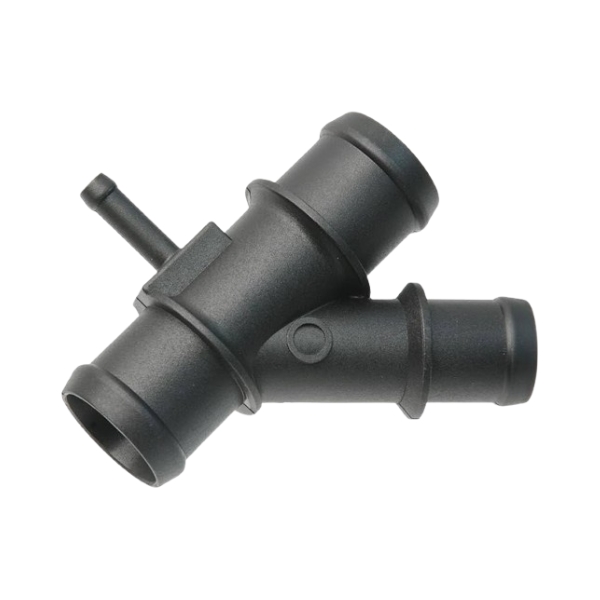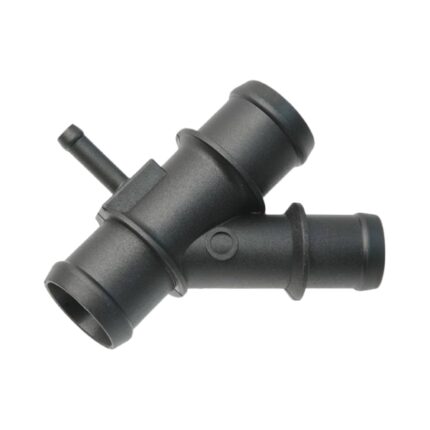Get VW Golf R-2.0T Coolant Hose Connector 1K0121087H in Kenya
The coolant hose connector is a vital component in a vehicle’s cooling system, playing a critical role in ensuring that the engine operates at the correct temperature. This overview will delve into the design, function, types, common issues, and maintenance of coolant hose connectors to provide a thorough understanding of their importance in engine management.
Design and Function
Design:
- Construction:
- Material: Coolant hose connectors are typically made from durable materials such as metal (aluminum or stainless steel) or high-quality plastic. These materials are chosen for their resistance to heat and corrosion, which are essential for withstanding the harsh conditions within the engine cooling system.
- Shape and Size: The connectors come in various shapes and sizes, including straight, angled, or Y-shaped designs, depending on their application within the cooling system. They are designed to fit snugly between hoses and other components to ensure a secure connection.
- Sealing Mechanism: Most connectors feature built-in seals or O-rings that provide a leak-proof connection. These seals are made from rubber or synthetic materials designed to handle the high temperatures and pressures of the coolant system.
- Functionality:
- Fluid Transfer: The primary function of a coolant hose connector is to join sections of coolant hoses together, allowing coolant to flow through the engine and radiator. This flow is essential for transferring heat away from the engine and maintaining optimal operating temperatures.
- Temperature Management: By facilitating the transfer of coolant, the connector helps regulate engine temperature, preventing overheating and ensuring that the engine operates efficiently. Proper coolant flow also contributes to the longevity of the engine and other related components.
Types of Coolant Hose Connectors:
- Straight Connectors:
- Design: Straight connectors are the most basic type and are used to connect two sections of coolant hose in a linear arrangement. They provide a straightforward solution for joining hoses without any change in direction.
- Applications: Commonly used in applications where the hoses run parallel to each other or where no angle or deviation is required.
- Angled Connectors:
- Design: Angled connectors have a bend or elbow that allows hoses to change direction. These connectors are essential for routing hoses around obstacles or aligning them with specific components.
- Applications: Used in scenarios where hoses need to be redirected or where space constraints necessitate a change in the hose path.
- Y-Connectors:
- Design: Y-connectors branch into two separate paths from a single input, allowing a single hose to split into two separate hoses. This type of connector is used to distribute coolant to multiple components.
- Applications: Common in cooling systems where coolant needs to be directed to different areas, such as cooling both the engine and an auxiliary component like a heater core.
- Quick-Disconnect Connectors:
- Design: Quick-disconnect connectors are designed for easy removal and installation without the need for tools. They often feature a locking mechanism that securely holds the connector in place while allowing for quick separation when needed.
- Applications: Useful in situations where frequent maintenance or servicing is required, such as during coolant system repairs or upgrades.
Common Issues with Coolant Hose Connectors
- Leaks:
- Causes: Leaks can occur due to worn or damaged seals, improper installation, or deterioration of the connector material. Over time, exposure to high temperatures and pressures can cause the seals or the connector itself to fail.
- Symptoms: Leaking coolant can be observed as puddles or drips under the vehicle or visible moisture around the connector area. Low coolant levels or overheating may also indicate a leak.
- Cracking or Splitting:
- Causes: The plastic or rubber components of coolant hose connectors can become brittle and crack due to prolonged exposure to high temperatures and coolant chemicals. Physical damage or improper handling during installation can also lead to cracking.
- Symptoms: Cracks or splits in the connector can lead to coolant leaks and reduced system efficiency. Visual inspection may reveal damaged or cracked connectors.
- Corrosion:
- Causes: Metal connectors, particularly those made of aluminum or steel, can corrode over time due to exposure to coolant and moisture. Corrosion can weaken the connector and lead to leaks or failure.
- Symptoms: Corrosion can manifest as rust or a white, powdery residue on metal connectors. This may be accompanied by leaks or a decrease in performance.
- Improper Fit:
- Causes: Connectors that are not properly sized or matched to the hoses can lead to poor sealing and leaks. Installation errors or using incorrect connectors can result in an inadequate fit.
- Symptoms: Poor fitting connectors may lead to coolant leaks, hose disconnections, or increased risk of hose damage. The connection may also appear loose or misaligned.
Maintenance and Replacement
- Regular Inspection:
- Visual Checks: Periodically inspect coolant hose connectors for signs of leaks, cracks, corrosion, or damage. Look for any visible signs of coolant around the connectors or on the ground beneath the vehicle.
- Coolant Level Monitoring: Keep an eye on coolant levels in the reservoir and the radiator. Significant drops in coolant levels may indicate a leak or issue with the connectors.
- Cleaning and Lubrication:
- Cleaning: If connectors are dirty or corroded, clean them with a suitable cleaner to remove debris and corrosion. Avoid using harsh chemicals that could damage the connectors or seals.
- Lubrication: Apply a small amount of lubricant or anti-seize compound to the connectors if needed, especially when reassembling or replacing them. This helps ensure a proper seal and makes future removal easier.
- Replacement:
- Timely Replacement: If a connector is found to be damaged, cracked, or leaking, it should be replaced promptly to avoid coolant system issues. Replacing a faulty connector is essential for maintaining proper coolant flow and preventing engine overheating.
- Correct Parts: Use OEM (Original Equipment Manufacturer) or high-quality aftermarket connectors that match the specifications of your vehicle. Ensure that the new connector is the correct size and type for your cooling system.
- Proper Installation:
- Secure Fitting: When installing a new connector, ensure that it is properly aligned and securely attached. Tighten any clamps or fasteners to the manufacturer’s specifications to prevent leaks and ensure a reliable connection.
- Seal Inspection: Check the seals or O-rings on the connector to ensure they are intact and properly positioned. Replace any damaged or worn seals to maintain a leak-proof connection.
- System Bleeding:
- Bleeding Procedure: After replacing a coolant hose connector or performing maintenance on the cooling system, it may be necessary to bleed the system to remove any trapped air. Follow the manufacturer’s recommended bleeding procedure to ensure that the cooling system is fully operational and free of air pockets.
Follow us on Facebook for more parts.




